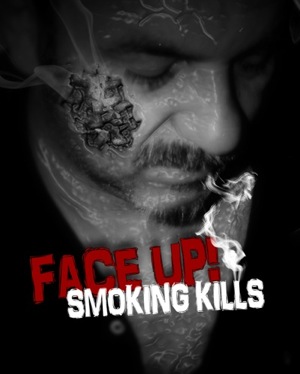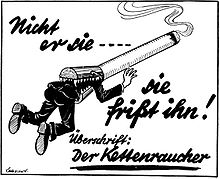
Smoking Cessation
last authored: Jan 2011, David LaPierre
last reviewed: Feb 2011, Sandy VanBiesbrouck
Introduction
Smoking is the single most preventable cause of premature illness and death, and we as health care providers must do our utmost to educate and support smokers.
Pharmacologic aids are recommended to everyone unless contraindiciated, and counselling should certainly also be provided. In fact, the combination of medication and counselling is synergistic, and is the current standard of care (US Public Health Service, 2008).

artwork by Nick Pereira; used with permission
While treatments are effective, unfortunately many patients will relapse. The various options provide alternatives for those who do not succeed on a given treatment.
Best practice includes intensive counselling and follow-up, with at least eight sessions. This has been difficult to translate into usual care, given the majority of health care delivery models. This includes lack of time for primary care providers, lack of funding for pharmacotherapy treatments, and difficulty coordinating care after hospital discharge.
Further work is therefore required to increase the implementation of strategies we know are very effective for people's health.
Benefits of Smoking Cessation
The benefits of quitting smoking are numerous. It prevents disease and reduces the impact for those who have already developed a disease or complication, especially cardiovascular disease or COPD.
- Lung cancer: after 10 years of quitting smoking, lung cancer rates are 30-50% less than in current smokers (Surgeon General, 1990).
- Cardiovascular disease: quitting after a heart attack or heart surgery led to a relative risk reduction of 36% in cardiovascular mortality (Critchley amd Capewell, 2003), and rates approached those of non-smokers after 3 years (Rea et al, 2002).
- COPD - quitting smoking slows the decline in FEV1 (Anthonisen et al, 1994).
- Stroke- quitting smoking reduces the relative risk from 3.7 to 1.7, compared with men who never smoked (Wannamethee et al, 1995).
- Pregnancy: quitting smoking reduces rates of low birth-weight and preterm birth (Lumley, Oliver, and Waters, 2000).
Risks of Smoking Cessation

Skull with a Burning Cigarette, Vincent Van Gough, 1886
Smoking cessation can cause weight gain and depression, at least in some. One study found former smokers were 4.4kg heavier for men and 5.0 kg heavier for women, compared with current smokers (Flegal et al, 1995).
Another study followed 100 smokers who had a history of major depression. Those who successfull quit had a higher rate of recurrent depression, OR 7.17 (95% CI 1.5-34.5) (Glassman et al, 2001).
Screening
Health care professionals should routinely ask all patients about their smoking status, including adolescents, adults, pregnant
Calculating pack years:
(#cigarettes smoked daily/20)
x (#years smoked)
women, and seniors.
A formal screening system can have a large impact on cessation rates (US Public Health Service, 2008). All hospitalized patients should be screened for smoking status, as cessation programs started in the hospital have good success (see below).
Screening should also include an assessment of a patient's readiness to quit smoking. The stages of change include:
- precontemplation - not considering change
- contemplation - considering pros and cons of making change
- preparation
- action
- maintenance
- relapse
Where a person is at should help shape the approach taken. Every smoker should be offered support in quitting, but without judgement. Most smokers knows smoking is harmful, and can easily feel threatened if pushed too much.
Understanding the Habit
Gain a deeper understanding of the smoking habit, asking about:
- age of onset
- number of cigarettes smoked daily
- time of the first cigarette
- past quit attempts
Nicotine Replacement Therapy (NRT)
A cigarette contains approx. 2mg of nicotine, and various products can be used to provide nicotine to the body, to lessen withdrawal and provide psychological reward. This can be described as "breaking the social habit of smoking, while slowing weaning physiological dependence."
Nicotine Replacement Therapy (NRT) includes nicotine gum, patches, lozenges, nasal spray, and inhalers. All have increase quit rates by 1.5-2 fold at 6 months in motivated patients. There is little evidence that one differs from another. The most effective regimen appears to be the patch plus another product (Stead et al, 2008).
These products are safe, though the gum can cause nausea, hiccups, and a sore jaw; the patch can cause headache, nausea, dizziness, and poor sleep; while inhalers can cause throat and nasal irritation, runny nose, sneezing, and coughing. A meta-analysis has shown no increase in cardiovascular events in people using NRT (Greenland, Satterfield, and Lanes, 1998).
Though costs are considerable, NRTs are a useful addition to anti-smoking endeavours. Smokers should be advised not to stop their NRT if they temporarily relapse.
Medications
There are two main medications that are used for smoking cessation.
Buproprion (Zyban) was the first smoking cessation medication. It blocks norepinephrine and dopamine reuptake. A meta-analysis of trials comparing bupoprion with placebo or no treatment showed a doubling of quit success at six months or longer (Hughes, Stead, and Lancaster, 2007).
Zyban is typically started 1-2 weeks before quitting. An initial dose of 150mg is used for three days, after which a maintenance dose of 150mg BID is used. Treatment usually lasts 7-12 weeks.
Varenicline (Champix) is a partial agonist of nicotinic acetylcholine receptors, believed to be responsible for dependency. Varenicline is thought to reduce withdrawal symptoms through agonist effects, to reduce craving through antagonist effects, and to block pleasurable effects of smoking. A meta-analysis revealed a OR of 3.22 (95% CI 2.43-4.27) at 52 weeks vs placebo. In trials comparing varenicline to buproprion varenicline was more successful, with an OR of 1.66 (95% CI 1.28-2.16) (Cahill, Stead, and Lancaster, 2007). However, extensive exclusion criteria and substantial industry funding require caution.
Varenicline is typically started 1 week before quit date. The inital dose is 0.5 mg for 3 days, followed by 0.5mg BID for 4 days, and then 1mg BID for the remainder of the 12 week treatment.
Second-line agents include nortryptiline and clonidine. SSRIs are not helpful.
Adverse Effects
Both bupoprion and varenicline have been given a boxed warning by the US FDA for serious mental health events, including behavior, depressed mood, hostility, and suicidal thoughts (source: FDA). Patients should be warned of these, and signs should be monitored.
The most common side effects of buproprion are dry mouth and insomnia. The risk of seizure is 1:1000, and is higher in those with seizure disorders or eating disorders.
The most common side effect of varenicline is nausea; insomnia and nightmares can also occur. Varenicline is excreted by the kidneys and should be used with caution in patients with renal dysfunction.
Brief Counselling
Use the five the 5 A's to help patients quit:
- Ask about smoking, and for permission
- Advise patient to quit
- Assess if they smoke, and want to quit
- Assist in quit attempt
- Arrange follow-up
Brief advice has been shown to increase quit rates, and health care providers should talk with patients at every opportunity about their smoking, even for 5 seconds. With an unassisted quit rate of 2 to 3%, brief advice can increase quitting by a further 1-3% (Stead, Bergson, and Lancaster, 2008).
Some helpful intial statements include: Can we talk about your smoking? and What do you think about quitting smoking?
The STAR approach:
- Set quit date
- Tell family and friends for support
- Anticipate challenges, ie withdrawal or triggers
- Remove tobacco products, ashtrays, lighters
Giving patients their "lung age" - the age of the average nonsmoker with the same FEV1 as the patient - increases rates of sustained cessation for those who were not interested in quitting. Quit rates were 6.4% of the control group and 13.6% in the intervention group (P = .005) (Parkes et al, 2008). It can also be helpful to advise patients to "Check your pulse before and after a cigarette - It doesn't calm you down!"
Self-help materials, such as patient handouts, have a very small effect, but certainly don't hurt.
If patients are unwilling to quit, share the five R's with them:
- Relevance to health
- Risk of smoking: SOB, asthma, impotence, infertility, pregnancy complications, heartburn, URTI
- Rewards of quitting: health, money, food tastes better, good example to children
- Roadblocks to quitting: fear of withdrawal or failure, weight gain, lack of support
- Repetition of discussion at each visit
Motivational interviewing has been used to help change many health behaviours, including smoking. It focuses on guiding the patient to change, exploring ambivalence and increasing attention to reasons and abilities for change. A central tenet is that patients' "change-talk" brings about much of the change.
An example of this is as follows: "On a scale of 1-10 where would you put yourself right now to try to quit smoking?" If under 7 then focus should be placed on increasing conviction & confidence. If 7 or over, offer options to help them quit.
A 2010 meta-analysis found, looking at 31 papers, that MI had an odds ratio of 1.45 (95% CI 1.14-1.83) compared to usual treatment. There was no difference noted on treatment duration (mean 1.5 hours), hours of staff training (mean 52 hours) or type of provider. The effect of MI was more significant among adolescents (OR 2.29) and non-existent among pregnant or post-partum women (OR 1.00). This suggests MI should be used preferentially in certain circumstances (Heckman, Egleston, and Hofmann, 2010).
Intensive Counselling

German anti-smoking ad, 1941
"He does not devour it ...it devours him!"
While brief advice can be helpful, and should be offered, greater benefit comes with more in-depth efforts at supporting cessation.
The more counseling, the better, and high-intensity (>10 minutes) is more effective than low-intensity (3-10 minutes), with an OR of 2.3 (CI 2.0-2.7) vs 1.6 (1.2-2.0). As well, more sessions appear better, with eight sessions OR 2.3 (CI 2.1-3.0) vs two-three sessions (OR 1.4 (CI 1.1-1.7) (US Public Health Service, 2008).
Other intensive approaches include:
- group counselling, though no evidence better than individual therapy (Stead and Lancaster, 2005).
- telephone counseling, more successful with multiple sessions and with an OR of 1.41 (1.27-1.57) (Stead, Perera, and Lancaster, 2006).
- web-based programs (Myung et al, 2009)
Of these, telephone counseling can be easily incorporated into primary care practice, by augmenting brief advice with a referral to the phone line.
In-Hospital Cessation Programs
There is substantial evidence that intensive, hospital-initiated programs which carry into the community can help patients who have suffered a heart attack and who want to quit, so much so that it is now considered 'best practice'. A successful intensive program has included 45-60 minutes of bedside education/counselling, followed by 7 nurse-initiated telephone counselling sessions after discharge. Counselling included patient-centred develeopment of behavioural, cognitive, and social support strategies for high-risk situations, while telephone counselling lasted 5-10 minutes and focused on reinforcement of the above strategies (Smith and Burgess, 2009).
In the above study, almost half of inpatients did not want to quit. Alternative strategies, such as motivational interviewing, could be used to increase ambivalence and move patients toward change.
A meta-analysis has shown that the postdischarge follow-up is critical for success, and with more than one month of support after leaving hospital, there was an 81% increase in odds of quitting (Rignotti, Munafo, and Stead, 2008).
Incentives
Many incentives in health care are aimed at health care providers. As patient behaviour is increasingly responsible for health outcomes, however, it makes good sense to aim incentives at patients directly. This can come in the form of decreased health premiums or direct payments. Offering up to $750 increases participation in smoking cessation programs and quit rates 9-12 months after (14.7% control vs. 5.0% incentives group, P<0.001) (Volpp et al, 2009). The savings to employers of having their employees stop smoking is estimated to be about $3,400 USD per year due to as a result of increased productivity, decreased absenteeism, and a reduced incidence of illness (CDC, 2002).
Policy, Taxes, and Education
Sugar, rum, and tobacco, are commodities which
are no where necessaries of life, which are become
objects of almost universal consumption, and which
are therefore extremely proper subjects of taxation. . . .
- Adam Smith, 1776, Book V, Chapter III, pp. 474
Due to the difficulties accompanying addiction, government intervention is useful. If only one intervention is taken, taxation has the greatest impact and is the most cost-effective. Taxation is an important means of reducing consumption while increasing revenues. For every 10% rise in price, tobacco use generally falls 2-10% (Chaloupka et al, 2000). This appears more true for smokers who are young or with low incomes.
Clean air laws protect non-smokers from the dangers of second-hand smoke, as well as encourage reduction or quitting of smoking.
Bans on advertising can reduce consumption. In countries where advertising is permitted, tobacco companies make advertising and promotion their single largest item of expenditure, often exceeding costs of raw tobacco leaf. (WHO, 2002).
Education, through warning labels, advertising, and other approaches are needed to reach the many people who do not fully understand the risks of tobacco use and benefits of quitting. Important efforts include:
- tobacco education in schools
- education to the general public about risks and quitting strategies
- specific education for smokers or high-risk folks
Resources and References
Anthonisen NR, Connet JE, et al. 1994. for the Lung Health Study Research Group. Effects of smoking intervention and the use of an inhaled anticholinergic bronchodilator on the rate of decline of FEV1. The Lung Health Study. JAMA. 272:1497-1505.
Aubin HJ, Bobak A, Britton JR, et al Varenicline versus transdermal nicotine patch for smoking cessation: results from a randomised open label trial. Thorax 2008;63(8):717-724.
Cahill K, Stead L, Lancaster T. 2007. Nicotine receptor partial agonists for smoking cessation. Cochrane Database Syst Rev. :CD006103.
Centers for Disease Control. Annual smoking-attributable mortality, years of potential life lost, and economic costs--United States, 1995-1999. Morb Mortal Wkly Rep. 51(14):300-3.
Chaloupka FJ, Hu TW, Warner KE, Jacobs R, Yurekli A. The taxation of tobacco products. In: Jha P, Chaloupka FJ, editors. Tobacco control in developing countries. Oxford: Oxford University Press; 2000. p.237-72.
Flegal KM, Troiano RP, Pamuk ER, Kuczmarski RJ and Campbell SM. The influence of smoking cessation on the prevalence of overweight in the United States. N Eng J Med 1995; 333: 1165-1175.
Glassman AH, Covey LS, Stetner F, Rivelli S. Smoking cessation and the course of major depression: a follow-up study. Lancet 2001;357:1929-32.
Heckman CJ, Egleston BL, Hofmann MT. 2010. Efficacy of motivational interviewing for smoking cessation: a systematic review and meta-analysis. Tobacco Control. 19:410-416.
Hughes Jr, Stead L, Lancaster T. 2007. Antidepressants for smoking cessation. Cochrane Database Syst Rev. CD000031.
Greenland S, Satterfield MH, Lanes SF. 1998. A meta-analysis to assess the incidence of adverse effects associated with the transdermal nicotine patch. Drug Safety. 18:297-308.
Lumley J, Oliver S, Waters E. Interventions for promoting smoking cessation during pregnancy. 2000. Cochrane Database Syst Rev. CD001055.
Myung SK, McDonnell DD, Kazinets G, Seo HG, Moskowitz JM. 2009. Effects of Web- and computer-based smoking cessation programs: meta-analysis of randomized controlled trials. Arch Intern Med. 169:929-37.
Parkes G, Greenhalgh T, Griffin M, Dent R. Effect on smoking quit rate of telling patients their lung age: the Step2quit randomised controlled trial. BMJ 2008;336:598-600.
Rea TD, Heckbert SR, Kaplan RC, Smith NL, Lemaitre RN, Psaty BM. 2002. Smoking status and risk for recurrent coronary events after myocardial infarction. Ann Intern Med. 137:494-500.
Smith PM, Burgess E. 2009. Smoking cessation initiated during hospital stay for patients with coronary artery disease: a randomized controlled trial. CMAJ. 180(13):1297-1303.
Stead LF, Lancaster T. 2005. Group behaviour therapy programmes for smoking cessation. Cochrane Database Syst Rev. (2):CD001007.
Stead et al. 2008. Nicotine replacement therapy for smoking cessation. Cochrane Library. 23(1):CD000146.
Stead LF, Bergson G, Lancaster T. 2008. Physician advice for smoking cessation. Cochrane Database Syst Rev. (2):CD000165.
Stead LF, Perera R, Lancaster T. 2006. Telephone counselling for smoking cessation. Cochrane Database Syst Rev. 3:CD002850.
Surgeon General. 1990. The Health Benefits of Smoking Cessation: A report of the Surgeon General. U.S. department of Health and Human Services (DHSS), Public Health Service (PHS), Center for Disease Control (CDC), Centre for Chronic Disease Prevention and Health Promotion, Office of Smoking and Health, DHSS Publication No. (CDC) 90-8416.
PHS Guideline Update Panel, Liaisons, and Staff. Treating tobacco use and dependence: 2008 update U.S. Public Health Service Clinical Practice Guideline executive summary. Respir Care. 2008;53:1217-22.
Volpp KG et al. 2009. A randomized, controlled trial of financial incentives for smoking cessation. N Engl J Med. 360(7):699-709.
Wannamethee SG, Shaper AG, Whincup PH, Walker M. 1995. Smoking cessation and the risk of stroke in middle-aged men. JAMA. 274:155-60.
World Health Organization. Guidelines for controlling and monitoring the tobacco epidemic. Geneva: World Health Organization; 1998.
